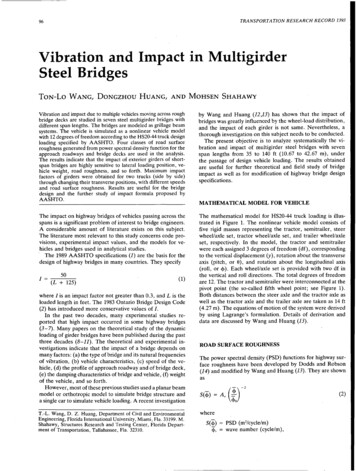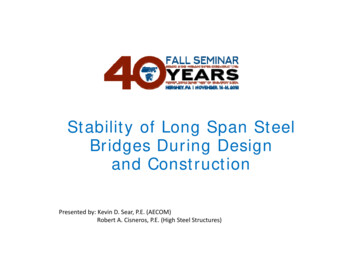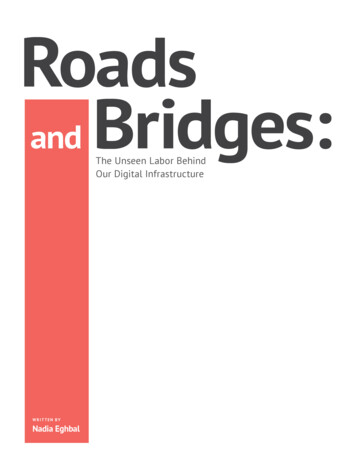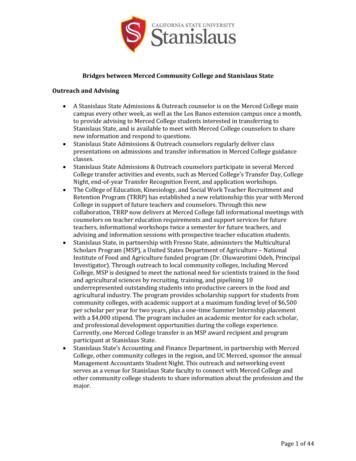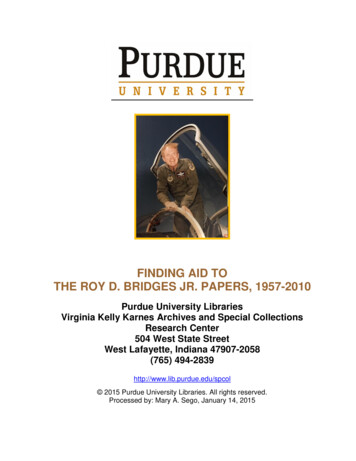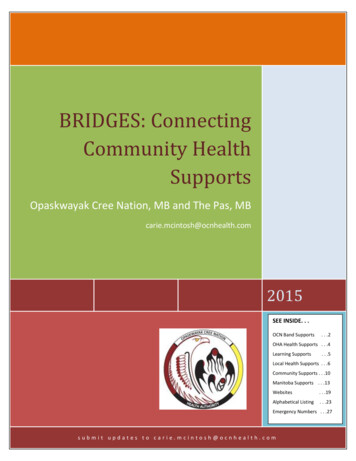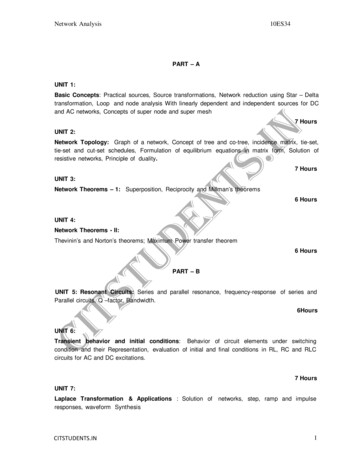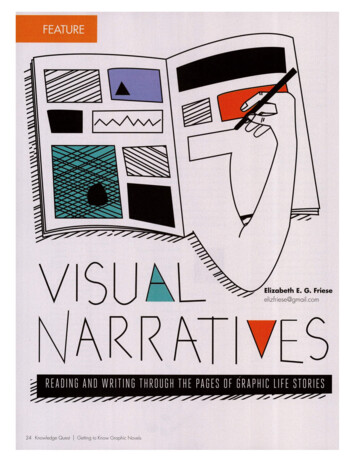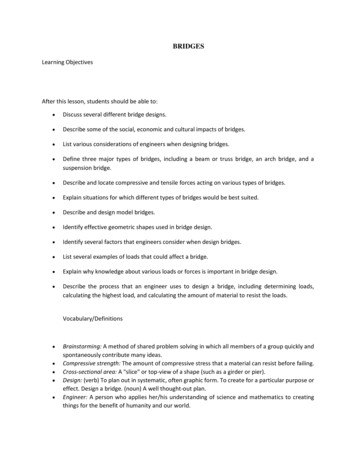
Transcription
BRIDGESLearning ObjectivesAfter this lesson, students should be able to: Discuss several different bridge designs. Describe some of the social, economic and cultural impacts of bridges. List various considerations of engineers when designing bridges. Define three major types of bridges, including a beam or truss bridge, an arch bridge, and asuspension bridge. Describe and locate compressive and tensile forces acting on various types of bridges. Explain situations for which different types of bridges would be best suited. Describe and design model bridges. Identify effective geometric shapes used in bridge design. Identify several factors that engineers consider when design bridges. List several examples of loads that could affect a bridge. Explain why knowledge about various loads or forces is important in bridge design. Describe the process that an engineer uses to design a bridge, including determining loads,calculating the highest load, and calculating the amount of material to resist the loads.Vocabulary/Definitions Brainstorming: A method of shared problem solving in which all members of a group quickly andspontaneously contribute many ideas.Compressive strength: The amount of compressive stress that a material can resist before failing.Cross-sectional area: A "slice" or top-view of a shape (such as a girder or pier).Design: (verb) To plan out in systematic, often graphic form. To create for a particular purpose oreffect. Design a bridge. (noun) A well thought-out plan.Engineer: A person who applies her/his understanding of science and mathematics to creatingthings for the benefit of humanity and our world.
Engineering: Applying scientific and mathematical principles to practical ends such as the design,manufacture and operation of efficient and economical structures, machines, processes andsystems.Engineering design: The process of devising a system, component or process to meet desiredneeds. (Source: Accreditation Board for Engineering and Technology, Inc.)Force: A push or pull on an object, such as compression or tension.Girder: The "beam" of a bridge; usually horizontal member.Load: Any of the forces that a structure is calculated to oppose, comprising any unmoving andunvarying force (dead load), any load from wind or earthquake (environmental load), and anyother moving or temporary force (live load).Member: An individual angle, beam, plate or built piece intended to become an integral part ofan assembled frame or structure.Pier: The "column" of a bridge; usually vertical member.Tensile strength: The amount of tensile stress that a material can resist before failing.Engineering ConnectionBridges are fascinating feats of engineering. Throughout history, humans have creatively designedeverything from rope and plank bridges to the Golden Gate Bridge. Today, primarily civil and structuralengineers are responsible for the design of bridges of which we have more than 500,000 in the U.S. thatare longer than 100 feet (30 meters). Since bridges must be safe under all anticipated load and weatherconditions, in designing today's modern bridges, engineers take into consideration tension andcompression forces. They also creatively strive to meet people's needs within budget and materialconstraints.IntroductionHave you ever placed a board or log over a stream so you can get across without getting wet? Have youever noticed when traveling in a vehicle how many bridges you cross to get to where you are going?Have you noticed the different types of bridges? What do they look like? Bridges are part of oureveryday lives; they usually go unnoticed and are taken for granted. Most bridges do not receive anykind of recognition. Often, they are only thought of as being part of the roadway, when in fact theycontribute heavily to commerce, urban development and social life. Bridges also impact cultural andenvironmental development. Some bridges even serve as national landmarks, symbols of theirrespective cities. Just as the Eiffel Tower in Paris, draws worldwide interest and testifies to engineeringexcellence, many bridges leave a similar impression and maintain a magnificent presence. For example,the Golden Gate Bridge in San Francisco, the Tower Bridge in London (see Figure 2), or the BrooklynBridge in New York City. These bridges, when built, caught the attention of the entire nation and theworld. Not only do they make possible transport between places for commercial and social purposes,but they bring people together, serving as significant attractions, generating tourism and pride in one'scity. Such bridges become symbols of their cities and are certainly unique
Figure 2. The Tower Bridge in London is three types of bridges in one. The shore-to-tower spans aresuspension bridges, the pedestrian walkways are truss (beam) bridges, and the center span is movableto allow tall ships to pass.Figure 3. A swinging cable and wooden plank bridge in a New Zealand rain forest.However, when you think about it, all bridges are unique. All bridges pass over a different roadway, river,bay, valley, canyon or railroad tracks. All of these obstacles are different and therefore the bridges thatcross them must be designed for those particular obstacles. In addition, a variety of geologic andenvironmental factors must be considered during the design process. This includes anchoring thefoundation, minimizing weathering from local climate conditions and minimizing environmental impactsduring and after construction, which includes sediment and airborne particle control.It is also important to consider why bridges have been constructed or used in the past. Some of the earliestbridges were no more than fallen (or cut) trees or logs. They were positioned to cross over small riversand ravines, so people could access other communities or resources for commerce, trade or social visits.We call these natural bridges. While natural bridges are inexpensive and effective for human travel, theyare almost impossible for moving heavy loads.Later bridges were made of rope with wooden boards. These bridges made it possible for more people tocross, and transport materials, carts and wagons. However, heavy loads were restricted from thesebridges due to the relative weakness of early rope. How would wind or rain affect these rope bridges?High winds might cause the bridge to sway and heavy rains could wash out the soil supporting the bridge,or even the bridge itself. Stone arch bridges, primarily built during the Roman Empire, are some of thestrongest and most durable bridges. Even today, many are still standing and being used in many parts ofEurope, Asia and the Middle East.In addition, other alternative bridge designs have been constructed, such as wire bridges for crossingravines, canyons and gorges (see Figure 3). In Nepal for example, some communities constructed
suspended wire bridges that span canyons and other extreme land features. In some cases, these bridgesresemble gondolas, and in other cases they are simple zip lines used for passenger and material transport.Today, the use of steel, concrete and cables lends greater material strength and enables the constructionof even larger bridges capable of supporting many automobiles, passengers as well as the weight of thebridge itself. Currently the state of Colorado has more than 8,000 bridges and the U.S. has more than500,000 bridges that are more than 100 feet (30 m) long! Civil and structural engineers are responsiblefor the design of bridges. They work in teams to determine the bridge type, design and materials; analyzesite conditions, geologic and environmental factors; and establish detailed design plans andbudget/funding schedulesIndeed, bridges are more than materials, designs and budgeting. Engineers must not forget the customers— the people and the community that use the bridge. Who might benefit from using a bridge and why?(Possible answers: Themselves, their families, businesses — for commerce, social gatherings, visitingfamily and friends, transportation to other areas, travel, etc.) Some people want a bridge for the access itprovides to resources, for expansion, for trade or industry, for the purpose of being connected to anothercommunity, city or region (see Figure 4).Figure 4. The many bridges in New York City make transportation possible for a huge populationWhat would it be like if we didn't have any bridges? Would we be able to get our favorite video games orshop at our favorite stores or visit our friends? Do you think we could effectively function as a societywithout bridges? People living during the 1850s were faced with this same situation when heading westto explore the U.S. frontier. They walked and traveled with covered wagons pulled by horses or oxen.Often they would either have to cross streams or rivers or travel many kilometers out of the way to findan adequate place to cross. If a river was particularly high or flooding, they were forced to wait days orweeks. For them, crossing rivers without bridges was dangerous and often disastrous. Countless examplesthroughout history are evidence that bridges serve as links for survival, an essential connection for theprosperity and well being of a city or community.Another example includes the Roman Empire, which relied heavily on the construction of roadways andbridges to expand the limits of its domain and, in one well documented case, the removal of one suchbridge spared the lives of many by eliminating access by their warring neighbors, the Etruscans.Lesson Background and Concepts for Teachers
Figure 5. Tension and compression forces acting on a spring.Three main types of bridges are beam (or truss), arch and suspension bridges. Usually, the obstacle to beovercome — another roadway, a river, a valley, a canyon, railroad tracks — is the main factor indetermining which bridge type is best to use. The obstacles that require bridges are many and varied. Oneunusual bridge might be a catwalk high above and across a theater stage, to provide access for lightingand props. Besides how these bridges look, the main difference in the three types of bridges is thedistances each type can safely span. Typical span lengths are: beam up to 200 feet (61 m), arch 130500 feet (40-152 m), and suspension 2,000-7,000 feet (610-2,134 m). The primary reason for thedifferences in span lengths is how each bridge type handles tension and compression forces.Figure 6. Tensile and compressive forces acting on a beam bridge; in a typical beam bridge tensile forcesare negligible. Compressive forces are indicated by red arrows and tensile forces are indicated by bluearrows.At any given time, two main forces act upon a bridge: compression and tension. Compression is a forcethat acts to compress or shorten the thing it is acting on. Tension is a force that acts to expand or lengthenthe thing it is acting on. As an example, think of a spring (see Figure 5). If we push both ends of the springtowards each other we are compressing the spring. Thus, a force of compression is acting to shorten thespring. If we pull both ends of the spring away from each other we are stretching the spring. Thus, a forceof tension is acting to lengthen the spring.Compressive and tensile forces are present in all bridges, and it is the job of engineers to design bridgescapable of withstanding these forces without buckling or snapping. Buckling occurs when compressiveforces overcome an object's ability to handle compression, and snapping occurs when the tensile forcesovercome an object's ability to handle tension. The best way to deal with these forces is to either dissipatethem or transfer them. To dissipate force is to spread it out over a greater area, so that no one spot hasto bear the brunt of the concentrated force. To transfer force is to move it from an area of weakness toan area of strength, an area designed to handle the force. An arch bridge is a good example of dissipation,while a suspension bridge is a good example of transference. Figures 6 and 7 illustrate tension andcompression forces acting on three bridge types.
Figure 7. Tension and compression forcesacting on an arch bridge (left) and suspension bridge (right). Compressive forces are indicated by redarrows and tensile forces are indicated by blue arrows.Beam (or Truss) BridgeA beam bridge is typically a simple structure made of horizontal, rigid beams. The beam ends rest on piersor columns. The weight of the beams (and any other load) is supported by the piers or columns.Compression force acts on the top portion of the beam and bridge deck, shortening these two elements.Tension force acts on the bottom portion of the beam, stretching this element. Figure 8 shows examplesof beam bridges.Figure 8. Example beam bridge construction. Left: Bilbao, Spain. Right: A modern highway bridge.Many beam bridges are constructed of steel, concrete, and (in some cases) wood. The beam size directlyinfluences the maximum span capability of the beam. A very large solid beam must be strong enough tosupport itself (it is very heavy) plus any other load on the beam. Therefore, as the span gets longer thebeam must be able to support more "self-weight."Beam bridges come in a variety of different styles. For example, a beam bridge might be made of solidbeams of steel, concrete, wood or other rigid material. Or, beams might be made with a hollow-center(reducing their weight). Beam bridges can also be composed of a truss system, which is a combination oftriangular units that use fewer materials and are simple to build. A truss is a structural form based on thegeometric rigidity of the triangle and composed of straight members. Many truss systems originated inthe mid-1800s and are still in use today. One example is a truss designed in 1840 — the Howe Truss —that combined diagonal and vertical members to create impressive strength over long spans; whichcontributed to its overwhelming popularity as a railroad bridge.Arch BridgeAn arch bridge
Design a bridge. (noun) A well thought-out plan. Engineer: A person who applies her/his understanding of science and mathematics to creating things for the benefit of humanity and our world. Engineering: Applying scientific and mathematical principles to practical ends such as the design, manufacture and operation of efficient and economical structures, machines, processes and systems .
